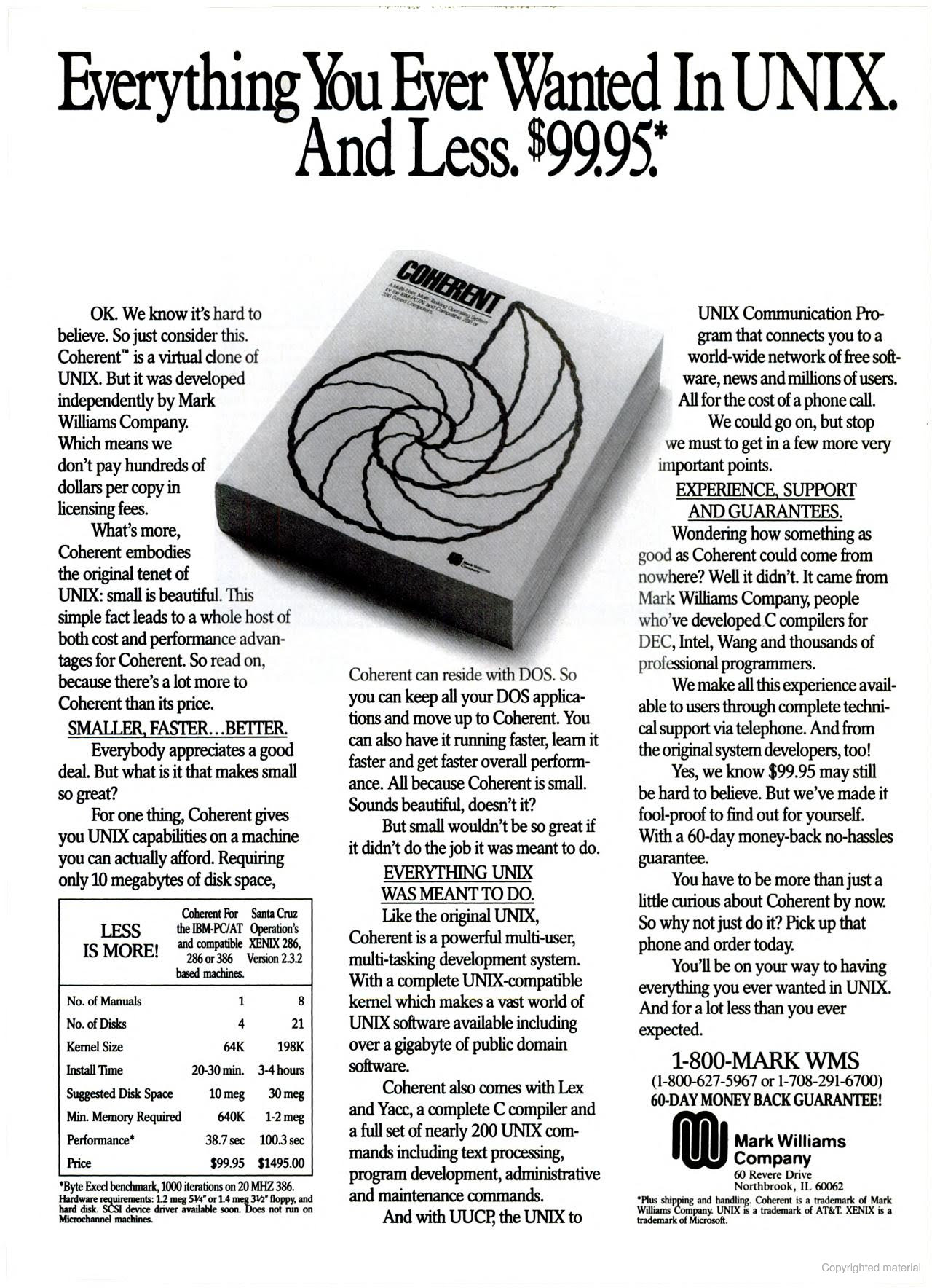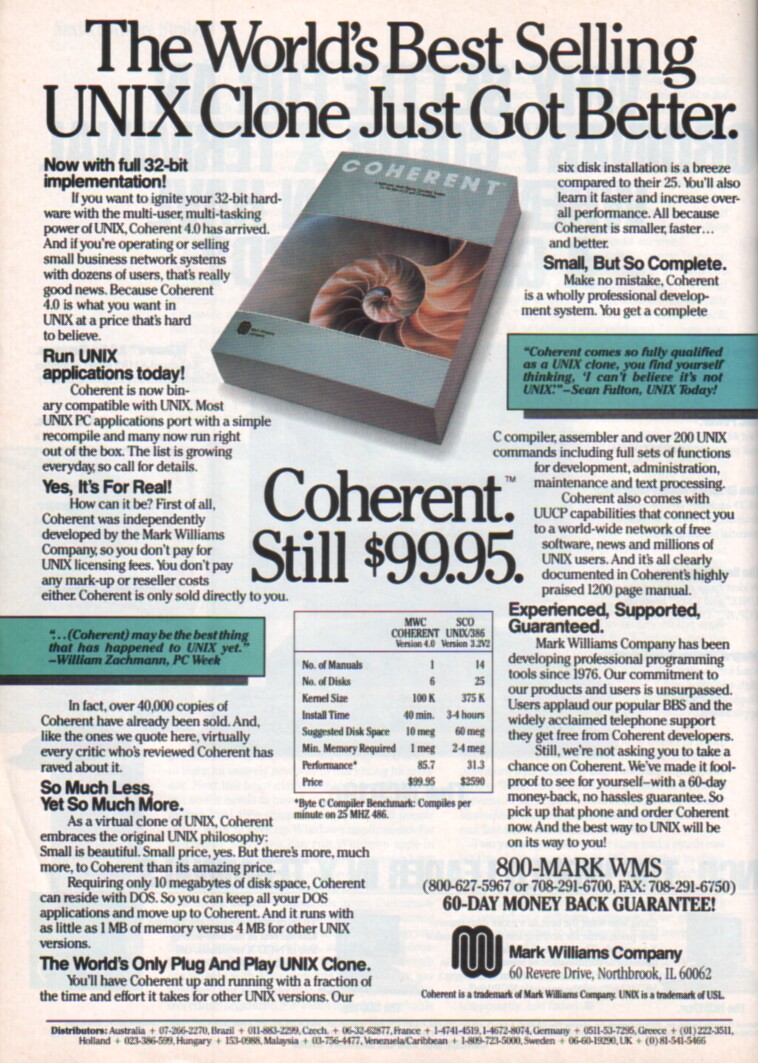
Here’s a blast from the past. Years ago, back in the early 1990s, there was an operating system called Coherent. The price wasn’t so bad – $99. A few years ago, it was made freely available. Coherent never claimed to be UNIX, but UNIX-like. I learned a lot with that OS.
When the Mark Williams Company closed in 1995, Coherent was a closed-source product. In 2015, it was released under a 3-clause BSD License so, if you’re interested, you can grab a free copy of Coherent at Internet Archive or here.
Here’s a little look-back at Coherent.
Coherent’s Requirements
Coherent was able to run on most Intel-based PCs with Intel 8088, 286, 386, and 486 processors. Coherent version 3, the version I started on, required at least a 286, and Coherent version 4 needed a 386. The drives that were supported were MFM or RLL.

Coherent 3.0 which was a clone of the AT&T V7 UNIX. It ran very well on a ‘386 and 20mb MFM drive. When Coherent 4.0 came out, I upgraded and also replaced the hard disk to a 40mb MFM unit. In both cases, Coherent ran on less than 10mb. Coherent 4 was closer to AT&T’s Sys5R4 UNIX.
Coherent 3.0 was a 16-bit OS but Coherent 4.0 was a bigger upgrade, able to take advantage of 32-bit operations. It still had a handful of programs limited to 16-bit operations, but all in all, it was a good system.
Coherent’s Offerings
For a small package, it was remarkably complete. Not only was it a standalone operating system, but came with a big box of goodies, such as a Bourne Shell, C compiler, assembler, debugger, DOS disk support, uucp, at least three editors, some games, mail, and around 200 of the most used and useful UNIX commands.

The shell had a few bugs and was missing some features, but it was sufficient for the small stuff I normally did with it. X Windows was available, but I don’t think it came with the basic system and, if I remember correctly, was a separate purchase. I remember having it and it worked, but it had a few problems, but the Mark Williams Company continually worked on it.
Using Coherent
Having a small UNIX system on a personal PC at home was nice. I was well versed with DOS, but UNIX was the operating system in use where I worked at the time and I preferred it over DOS and Windows 3.1. Coherent wasn’t as powerful as UNIX but it was a good learning tool. With it, I learned much about system administration and got a massive amount of hands-on experience with the command line.
Programming was fun, but since the C compiler only had small model support (64K of code and 64K of data), I was limited in what programs I could write. Some might laugh at the small model, but some nifty programs could be written with it.
Using Coherent at home, I was a single user, using it mainly for the experience with the command line and to learn a bit about system administration.
I really can’t recall how well Coherent handled networking; I never concerned myself with it. I don’t recall it having a lot of network support – it certainly didn’t have TCP/IP. However, it did have uucp. It took me some time to get it working right, but once that was done, it delivered all the Usenet news I could ever want.
One might think that it wouldn’t do well in a large setting, such as a school, but I attended one college that actually had several Coherent workstations. They were used mainly as training stations for classes in operating systems.
The XWindows vs. TCP/IP Argument
There are some arguments over whether or not the Mark Williams Company’s efforts on XWindows was wise, or if they should have concentrated on implementing a TCP/IP stack. To some, this is the main reason why the Mark Williams Company folded.
The Mark Williams Company spent a lot of time and effort on getting X Windows to work. I don’t recall that they truly finished, but they had at least gone a long way toward completing it. It makes sense to me that they would focus on it – the goal was to make an affordable UNIX-like system and X was definitely considered a part of UNIX.
A small company would have to choose its projects carefully. XWindows was chosen. Even Linux, in its early days, didn’t offer TCP/IP support at first – KA9Q was used for a short time, so I don’t think that the decision to focus on XWindows was unwise at all.
Conclusion
Coherent just couldn’t keep up with the competition and the Mark Williams Company closed in 1995. I certainly don’t consider Coherent a failure in the slightest, however. It was an excellent UNIX option at the time and the efforts of the Mark Williams Company was quite impressive.
I learned more about the command line and general system administration than I ever could have where I worked at the time. I once recommended Coherent to an individual who wanted to learn UNIX on her own. After a year with it, she hired on as a system administrator. The last I heard from her, she was the senior UNIX admin at a large site in the Midwest US.
I’m right glad that I got to play with Coherent. I credit Coherent with being a key part in my education; it had a part in how my career developed and I went on to be a system administrator on different UNIX systems.
At home, I would eventually settle on Linux – a decision I do not regret, but if you decide to play with it remember that it’s old – you will be experiencing a bit of history. If you would like to try out Coherent, you can run it through VirtualBox. Thorough setup instructions can be found at: https://www.autometer.de/unix4fun/coherent/. Not only does the page cover VirtualBox setup, but the page also contains a link to disk images and installation instructions – a one-stop site.
It's FOSS turns 13! 13 years of helping people use Linux ❤️
And we need your help to go on for 13 more years. Support us with a Plus membership and enjoy an ad-free reading experience and get a Linux eBook for free.
To celebrate 13 years of It's FOSS, we have a lifetime membership option with reduced pricing of just $76. This is valid until 25th June only.
If you ever wanted to appreciate our work with Plus membership but didn't like the recurring subscription, this is your chance 😃

